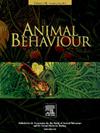Importance of visual and chemical cues in infection detection and avoidance in freshwater fish
IF 2.3
2区 生物学
Q2 BEHAVIORAL SCIENCES
引用次数: 0
Abstract
The characteristics of infected animals, including their odour, appearance, behaviour and sound, greatly differ from those of uninfected conspecifics. These differences can serve as cues to recognize and avoid infected individuals and minimize the risk of infection. Avoidance of infected conspecifics is a risk-sensitive behaviour that can be influenced by various factors, including sensory cues, which are poorly understood in fish. We investigated the ability of two populations of wild-caught pumpkinseed sunfish, Lepomis gibbosus, to distinguish between conspecifics infected with parasitic worms and uninfected individuals in two-choice experiments using visual and chemical cues separately. One population was from a lake without parasites (parasite-naïve), whereas the second population originated from a lake with a high prevalence of trematode and cestode worms (parasite-experienced). Both populations preferred to be with conspecifics, regardless of their infection level, over being alone when given visual cues but avoided conspecifics and preferred to be alone when given chemical cues, suggesting that visual and chemical cues are not redundant. Fish from neither population showed a preference between infected and uninfected conspecifics when given visual cues. However, there was a large interindividual variation in preference for chemical cues: some fish preferred uninfected conspecifics, whereas others preferred infected fish. On average, naïve fish avoided infected conspecifics, whereas experienced fish did not show any preferences, suggesting that fish from lakes with high prevalence of infection are habituated to infection cues. We suggest that pumpkinseeds use chemical rather than visual cues to discriminate between infected and uninfected conspecifics during shoaling decisions. Our study highlighted the importance of considering different sensory cues as well as environmental parasite abundance when studying avoidance and shoaling behaviours, especially considering the growing impacts of global changes on the sensory landscape and parasite abundance in freshwater ecosystems.
求助全文
约1分钟内获得全文
求助全文
来源期刊

Animal Behaviour
生物-动物学
CiteScore
4.60
自引率
8.00%
发文量
236
审稿时长
10.2 weeks
期刊介绍:
Growing interest in behavioural biology and the international reputation of Animal Behaviour prompted an expansion to monthly publication in 1989. Animal Behaviour continues to be the journal of choice for biologists, ethologists, psychologists, physiologists, and veterinarians with an interest in the subject.
 求助内容:
求助内容: 应助结果提醒方式:
应助结果提醒方式:


